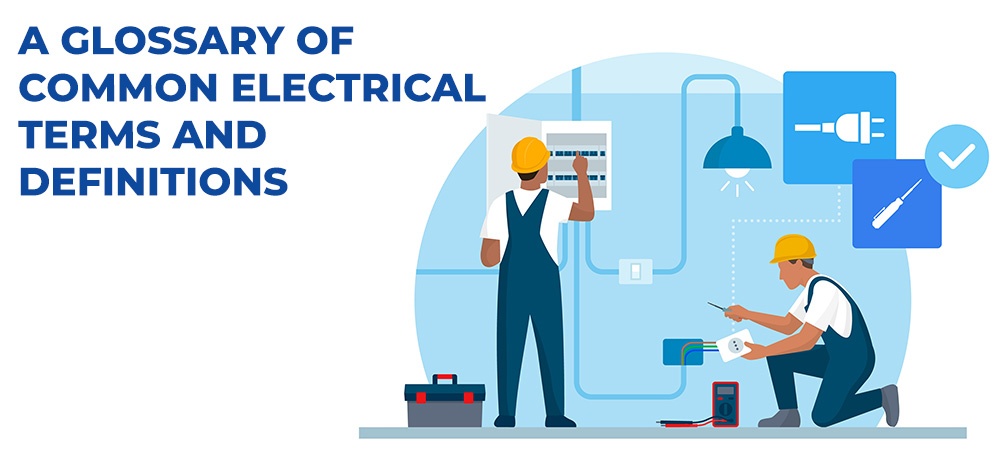A Glossary Of Common Electrical Terms and Definitions

Every industry has its language and terms. These words and phrases can be confusing to anyone who is not part of the daily operations of a specific sector, and the electrical industry is no exception.
To help you understand the terms, acronyms, and phrases regularly used when dealing with electric solutions, Bryant Electric Ltd. has created this handy reference guide. Here you’ll find valuable information allowing you to comprehend and communicate your installation, power distribution, cabling and lighting needs effectively.
Voltage
Voltage, also called an electromotive force (EMF), is what makes electric charges move. It is the ‘push’ that causes charges to move in a wire or other electrical conductor and is expressed in volts (V).
Current
A current is a flow of electricity that results from the ordered directional movement of electrically charged particles. Current is measured in amperes (A).
Transformer
This is a device made of two coil windings that transfers voltage from one coil to the next through electromagnetic induction. Transformers either increase or decrease voltage while transferring electric energy from one alternating-current circuit to one or more circuits.
Watt
A “watt” is a measure of power indicating the electrical power applied in a circuit. It is calculated by the following formula: watts = amperes x volts.
Relay
A relay is an electrically operated coil switch that uses a small current to control a much larger current. It consists of input terminals for single or multiple control signals and a set of operating contact terminals.
Resistance
Electrical resistance is a force that counteracts the flow of current. It is the opposing force in a circuit to the passage of electrical current and can be compared to the friction experienced by water when flowing through a pipe. Electrical resistance is measured in ohms.
Ground
In electrical engineering, ground or earth is a reference point in an electrical circuit from which voltages are measured, a common return path for electric current, or a direct physical connection to the earth. A grounding wire gives an appliance or electrical device a safe way to discharge excess electricity.
Ground Fault Circuit Interrupters (GFCI)
The ground-fault circuit interrupter, or GFCI, is a fast-acting circuit breaker designed to shut off electric power in the event of a ground fault within as little as 1/40 of a second. It works by comparing the amount of current going to and returning from equipment along the circuit conductors. It is recommended that GFCIs be installed in areas where appliances and power tools are used in close proximity to water.
Frequency
Frequency refers to the number of times the alternating current (AC) switches between positive and negative in 1 second or the number of pulse or wave cycles completed in that time. Frequency is measured in hertz, as in 60Hz (hertz) per second.
Direct Current (DC)
Direct current (DC) is a one-directional flow of electric charge. It is a steady flow of electrons moving steadily and continually in the same direction along a conductor from the point of high potential to one of lower potential. It is produced by a battery, generator, or rectifier.
Alternating Current (AC)
An alternating current (AC) is an electric current that periodically reverses direction and changes its magnitude continuously with time. Alternating current is the form in which electric power is delivered to businesses and residences, and it is the form of electrical energy that consumers typically use when they plug kitchen appliances, televisions, fans and electric lamps into a wall socket.
Light Emitting Diode (LED)
An LED is a solid-state display device that emits infrared or visible light when charged with an electric current. Light is produced when the particles that carry the current known as electrons combine within the semiconductor material.
Polarity
This is a collective term applied to the positive (+), and negative ( - ) ends of a magnet or electrical mechanisms such as a coil or battery.
Insulator
An electrical insulator can be any material where the electric current does not flow freely. Materials such as glass, rubber, air, and many plastics have relatively high resistance. Insulators protect you and your equipment from electric shock.
Kilowatt-hour (kWh)
The kilowatt-hour (symbolized kWh) is a unit of energy equivalent to one kilowatt (1 kW) of power expended for one hour (1 h) of time. The kilowatt-hour is not a standard unit in any formal system, but it is commonly used in electrical applications. The formula used to calculate this is kWh = (watts × hrs) ÷ 1,000.
If you’re looking for licensed electrical contractors in Prince George and Terrace, BC, reach out to the experts at Bryant Electric Ltd. Our company was formed in 1960. Over the past six decades, we have built up a loyal client base by rendering quality services consistently. Our electrical services include fiber-optic installations, fire alarm installations, emergency lighting installations, lighting retrofits, preventive electrical maintenance, and HVAC equipment installations. We offer our electrical services to a large region in Northern British Columbia from our offices in Prince George and Terrace. We’ve also secured multiple national accounts, which have taken us far and wide.
Please view our complete list of services here, or get in touch with us here.